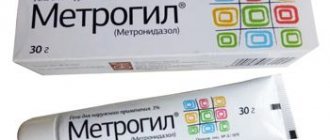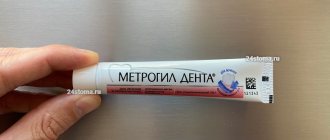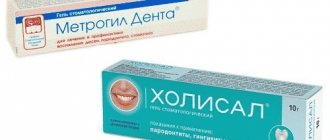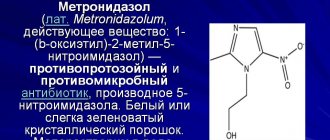Causes
The development of gingivitis in pregnant women may be associated with changes in hormonal levels, which are characterized by:
| increased concentrations of estrogens, progesterone, prostaglandins | the appearance of toxicosis |
However, hormonal changes usually only predispose to the occurrence of gingivitis, and its actual causes are as follows:
- accumulation of soft plaque due to poor oral hygiene;
- exacerbation of sluggish chronic gingivitis during pregnancy.
Up to contents
Is it possible to use Metrogyl Denta during pregnancy?
Metrogyl Denta is a medicine whose course use helps restore gum health. This ability of the gel is especially in demand during pregnancy. A woman’s body experiences excessive stress due to changes in hormonal levels, which provoke calcium deficiency. And a decrease in immunity often leads to the activation of bacteria belonging to an opportunistic biocenosis. They cause the development of oral pathologies and deterioration of the gums and teeth. Metrogyl Denta successfully copes with all negative symptoms:
- heavy dental plaque;
- redness and swelling of the mucous membranes;
- bleeding even with a light touch;
- burning, stinging and pain during eating.
The dental preparation not only eliminates clinical manifestations, but also affects the cause of the disease - pathogenic microorganisms. Therefore, when asked by pregnant women whether Metrogyl Denta can be used, doctors answer positively. But not during the first trimester of pregnancy, when the formation of the fetus begins.
Potential Harm
During pregnancy, you can use Metrogyl Denta after the end of the first trimester. According to the results of clinical studies, it is safe during this period for the intrauterine development of the fetus. If a woman used the drug for preventive purposes before conception, it is now better to abandon it. Any pharmacological load is undesirable during the period of bearing a child. To prevent the development of gingivitis or periodontitis, you can rinse your mouth with infusions of medicinal herbs:
- chamomile;
- sage;
- oak bark.
In the early stages of pregnancy, the internal organs of the fetus are just beginning to form, the kidneys and stomach are just beginning to function. Metrogyl Denta contains two ingredients that are not antibiotics, but have their properties. Therefore, there is a potential for the development of congenital anomalies.
In the first trimester of pregnancy, you should take any medications only as prescribed by your doctor.
At the first symptoms of gum disease, you should contact your dentist as soon as possible. Treatment of periodontitis or stomatitis at the initial stage is often done without the use of drugs.
Symptoms
1st half of pregnancy.
Typically, symptoms of gingivitis occur in the 3-4th month of pregnancy, since during this period intense hormonal changes occur, leading to the development of the catarrhal form of the disease. Gingivitis manifests itself as follows:
- bleeding gums;
- pain when brushing teeth;
- swelling of the marginal part of the gums and gingival papillae;
- change in gum color (first redness, then blueness).
2nd half of pregnancy.
Inflammation, accompanied by swelling and bleeding, worsens. The gingival papillae and marginal gums may begin to grow. This type of gingivitis is called hypertrophic. It is especially pronounced in the area of the front teeth and in places where there are overhanging edges of crowns and fillings that injure the gums. Hypertrophic gingivitis comes in two forms:
- edematous – the gingival papillae enlarge, become blue in color, become soft to the touch, have polypous growths or a loose structure;
- fibrous – the gingival papillae enlarge and at the same time become dense.
Up to contents
Description of the drug
If, during dental treatment, the doctor diagnoses gum inflammation, the patients are prescribed antimicrobial drugs. Metrogyl Denta is active against most infectious agents of dental diseases. These are gram-negative and gram-positive anaerobes and aerobes, some types of protozoa. Course use of the drug is recommended for the following purposes:
- prevention of active growth and reproduction of pathogenic microorganisms and their complete destruction;
- preventing the spread of the inflammatory process to healthy tissues of the oral cavity.
Metrogyl Denta is prohibited for use in the first trimester of pregnancy.
Its use is possible only during periods of intensive fetal growth. When the child’s organs are already formed, the ingredients of the drug do not have a negative effect.
pharmachologic effect
Patients often ask dentists whether pregnant women can use Metrogyl Denta gel.
It contains metronidazole, which is not advisable to use while pregnant. But if the dosages are observed, the chemical compound practically does not penetrate into the systemic bloodstream. The action of Metrogyl Denta is based on the pharmacological properties of its ingredients. During biochemical reactions, the nitro groups of metronidazole molecules are restored. This process occurs with the participation of intracellular transport proteins:
- protozoa;
- anaerobic bacteria.
After reduction, nitro groups are integrated into the DNA chains of microorganisms and begin to inhibit the biosynthesis of nucleic acids. As a result, bacteria lose their ability to grow and reproduce, which causes their death. Metrogyl Denta exhibits bactericidal activity against the following infectious agents:
- Borrelia vincenti;
- Fusobacterium fusiformis;
- Eikenella corrodens.
Chlorhexidine exhibits pronounced antiseptic activity. Dissociation of its salt occurs with the formation of cations. They react with bacterial cell walls and disaggregate them. As a result, the osmotic balance is disrupted, the cytoplasmic membranes are destroyed, and the microbes die.
Release form and composition
Metrogyl Denta is produced in India. It is produced in the form of a gel of thick consistency, opalescent, white, with a pleasant menthol odor. The drug is packaged in 5.0 g, 10.0 g, 20.0 g in soft plastic tubes. In addition to metronidazole and chlorhexidine, it contains the following ingredients:
- levomenthol;
- propylene glycol;
- carbopol;
- purified water;
- sodium saccharinate;
- sodium hydroxide;
- disodium salt of ethylenediaminetetraacetic acid.
Due to the content of levomenthol in the gel, after its application you feel coolness, pain and burning disappear. And propylene glycol and carbopol ensure rapid absorption of ingredients into the mucous membranes of the oral cavity. Secondary packaging of Metrogyl Denta is a cardboard box with an attached annotation. The shelf life of the drug is 36 months. The dental product must be stored in a place protected from light at a temperature not exceeding 25°C. The average cost of 20.0 g in pharmacies is 260 rubles.
Treatment of catarrhal gingivitis
Treatment tactics depend on the stage of pregnancy. A course of therapy can only be prescribed by a doctor!
Removal of dental plaque.
Ultrasonic teeth cleaning is contraindicated for pregnant women, so hand tools are used to remove plaque. After the procedure, the teeth are polished.
Antimicrobial therapy.
The course may include rinsing with antiseptic mouth rinses, as well as the use of special medicinal gels and toothpastes.
Maintaining oral hygiene.
It is necessary to brush your teeth twice a day - in the morning and before bed, and after each meal. It is also necessary to use floss. Regular use of a mouthwash such as LISTERINE® is also important.
Up to contents
Gel Metrogyl Denta
Instructions for medical use of the drug
Description of pharmacological action
It has an antibacterial effect against anaerobic bacteria that cause periodontal diseases: Porphyromonas gingivalis, Prevotella intermedia, Fusobacterium fusiformis, Wolinella recta, Eikenella corrodens, Borrelia vincenti, Bacteroides melaninogenicus, Selenomonas spp.
Indications for use
Infectious and inflammatory diseases of periodontal and oral mucosa: - acute and chronic gingivitis; — acute ulcerative-necrotizing gingivitis of Vincent; — acute and chronic periodontitis; — juvenile periodontitis; - periodontal disease complicated by gingivitis; - aphthous stomatitis; - cheilitis; - inflammation of the oral mucosa when wearing dentures; — post-extraction alveolitis (inflammation of the socket after tooth extraction); - periodontitis, periodontal abscess (as part of combination therapy).
Release form
gel for use in dentistry; plastic tube of 5,10,20,30 or 50 g, cardboard pack 1; gel for use in dentistry; aluminum tube of 5,10,20,30 or 50 g, cardboard pack 1;
Pharmacodynamics
The effectiveness of the drug is due to the presence of two antibacterial components in its composition: a) metronidazole has an antibacterial effect against anaerobic bacteria that cause periodontal diseases: Porphyromonas gingivalis, Prevotella intermedia, Fusobacterium fusiformis, Wolinella recta, Eikenella corrodens, Borrelia vincenti, Bacteroides melaninogenicus, Selenomonas spp. b) chlorhexidine is a broad-spectrum antiseptic that has a bactericidal effect against vegetative forms of gram-negative and gram-positive microorganisms, as well as yeast, dermatophytes and lipophilic viruses.
Pharmacokinetics
When applied topically, Metrogyl Denta gel is practically not absorbed.
Use during pregnancy
It is not recommended to prescribe the drug to pregnant women in the first trimester of pregnancy. During lactation, the issue of stopping breastfeeding should be decided.
Contraindications for use
individual intolerance to metronidazole, chlorhexidine, as well as nitroimidazole derivatives and any components included in the drug; children under 6 years of age.
Side effects
When using Metrogyl Denta gel topically, the risk of developing systemic side effects is low, but sometimes the following may occur: headache, allergic reactions (skin rash, itching, urticaria).
Directions for use and doses
Topically, for dental use only. For adults and children over 6 years old with gum inflammation (gingivitis), Metrogyl Denta is applied to the gum area 2 times a day; it is not recommended to wash off the gel. The duration of treatment is on average 7–10 days. After applying the gel, you should refrain from drinking and eating for 30 minutes. In case of periodontitis, after removing dental plaque, periodontal pockets are treated with Metrogyl Denta gel and the gel is applied to the gum area. Exposure time - 30 minutes. The number of procedures depends on the severity of the disease. In the future, the patient can apply the gel independently: Metrogyl Denta is applied to the gum area 2 times a day for 7–10 days. For aphthous stomatitis, Metrogyl Denta is applied to the affected area of the oral mucosa 2 times a day for 7–10 days. To prevent exacerbations of chronic gingivitis and periodontitis, Metrogyl Denta gel is applied to the gum area 2 times a day for 7–10 days. Preventive courses of treatment are carried out 2–3 times a year. To prevent post-extraction alveolitis after tooth extraction, the hole is treated with Metrogyl Denta® gel, then the gel is applied on an outpatient basis 2-3 times a day for 7-10 days.
Overdose
There were no cases of drug overdose with topical use.
Interactions with other drugs
When applied topically in recommended doses, no systemic interaction of Metrogyl Denta gel with other drugs was detected.
Special instructions for use
The use of Metrogyl Denta gel does not replace hygienic brushing of teeth, therefore, during the course of treatment with the drug, teeth brushing should be continued.
Storage conditions
List B.: At a temperature not exceeding 25 °C.
Best before date
36 months
ATX classification:
A Digestive tract and metabolism
A01 Dental preparations
A01A Dental preparations
A01AB Antimicrobials for topical use in diseases of the oral cavity
A01AB11 Other antimicrobials
Treatment of hypertrophic gingivitis
Therapy includes all of the above methods. If the cause of gum overgrowth is traumatization of the gums by the overhanging edges of crowns and fillings, their shape is corrected. In severe cases of the disease, sclerosing therapy (injections of sclerosing solutions into the gingival papillae) may be prescribed. Also, in some cases, the gingival margin is corrected surgically. This treatment is prescribed after childbirth. Only a doctor can select adequate therapy.
Up to contents
The information in this article is for reference only and does not replace professional advice from a doctor. To make a diagnosis and prescribe treatment, consult a qualified specialist.
Instructions for use
In the later stages of pregnancy, the dentist prescribes it when infectious and inflammatory pathologies of the mouth are detected. A woman should not ignore medical recommendations. Any untreated infection will cause symptoms of general intoxication of the body. Such an action will negatively affect the intrauterine growth and development of the fetus and harm the health of the mother.
The duration of therapy recommended during pregnancy in the instructions for use of Metrogyl Denta is 5-14 days. When carrying a child, the drug is prescribed for the shortest possible time and in low doses . This helps minimize the likelihood of side effects. Breastfeeding should be discontinued during treatment with dental gel.
Indications and contraindications
A contraindication to the use of Metrogyl Denta during pregnancy is intolerance to the active or auxiliary ingredients. Also, it cannot be used to prevent gingivitis and other dental pathologies. The gel is prescribed to patients when diagnosing the following periodontal diseases:
- Vincent's ulcerative necrotic gingivitis;
- post-extraction alveolitis;
- acute or chronic periodontitis.
The drug is used to treat cheilitis - inflammation that affects the red border, mucous membrane and skin of the lips. It quickly destroys infectious agents of stomatitis, especially its aphthous form.
Scheme of use during pregnancy
From the second trimester of pregnancy, a thin layer of Metrogyl Dent should be applied to the gums in the morning and evening. The procedure should be carried out only with clean hands using a cotton pad or swab.
After application, you should refrain from eating food and water for 30-40 minutes.
If periodontitis is detected during pregnancy, then Metrogyl Denta gel is used after cleaning the tartar. The dentist will show the woman how to treat a periodontal pocket. In the future, she carries out the procedure independently at home. The average duration of use is 7-10 days.
Side effects
In the second and third trimesters of pregnancy, the use of Metrogyl Denta may cause the development of allergies. Clinically, it manifests itself in the form of small rashes, itching, swelling and redness of the skin.
Is it possible to treat teeth during pregnancy?
Most likely, the tooth will decay during this time (the bulk of the minerals go to build the fetal body), damage neighboring ones, and also become a source of infection for the newborn. Let's add a change in the properties of saliva, which, due to its increased viscosity, cannot fully wash and protect teeth, and weak mineralization.
The answer is clear: treat. To do this, you need to choose the right time, place, specialist and materials. The specialists at SM-Dentistry treat their patients very carefully and choose only safe treatment methods.
Dental prevention during pregnancy
- Treatment of carious teeth and periodontitis before pregnancy.
- Careful dental and oral care. In addition to mandatory brushing of teeth 2 times a day with high-quality toothpaste, it is recommended to use dental floss and rinse to prevent gum disease. You can use gels that restore enamel mineralization, reduce sensitivity and stop caries in the early stages.
- Nutrition should be complete; you can supplement it with vitamin and mineral complexes on the recommendation of the obstetrician-gynecologist who is managing the pregnancy and your trusted dentist.
- Preventive examinations in every trimester. Professional cleaning is usually carried out 2 times a year.
Finding your dentist is no less important than finding a gynecologist. When you trust a specialist, any manipulation will be easy and positive, which will definitely have a positive effect on the health of both mother and child.











